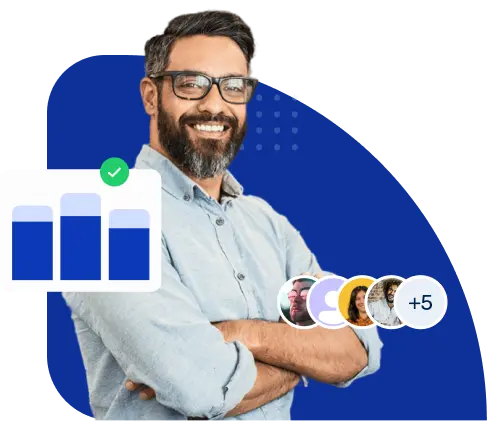Counted among the best front-end development companies in India, we cover a wide array of front-end services that include:
We understand your specific needs and build a front-end that perfectly complements your app’s functionality.
Boost performance and enhance UX flexibility with our single-page application development services.
Our custom front-end development services create sleek front-end designs for your apps for engaging user experiences.
With proven experience in UI/UX design and app development, we build cross-device customer-facing interfaces.
We can set up a responsive, robust, and scalable Content Management System for your business. Our team can also make it customized to meet your individual needs.
Our PWA development services replicate native apps, providing a seamless user experience and enhanced functionality.
We don’t just build interfaces; we create experiences. Our team implements captivating animations, seamless transitions, and stunning scroll effects to keep your users glued to the screen.
We ensure your website or app functions flawlessly across all major browsers, from Chrome to Firefox. This guarantees every visitor a consistent and frustration-free experience, regardless of their browser choice.
Speed is key. We leverage CI/CD pipelines to streamline the entire development process. This means lightning-fast updates and seamless deployment of new features and enhancements for your web applications.
Discover the potential of your online platform with our front-end development expertise, crafting visually stunning interfaces that captivate your audience and boost brand credibility.

At PixelCrayons, delve into the realm of superior front-end development where innovation and quality converge seamlessly with efficiency.
Our proficient team, handpicked from India’s top 1% software talent, comprises adept app consultants, programmers, and designers committed to furnishing secure, resilient, and cost-effective solutions.
Experience next-level digital marketing and transformation services to unleash your online potential.
Regardless of your business size or sector, our software engineering expertise is designed to elevate your operations.






Tailoring the Approach to Your Needs

Embrace the culture of collaboration and continuous improvement with DevOps. Our approach integrates development and operations for faster delivery, higher software quality, and more reliable releases, enhancing responsiveness to market changes.

Adopt a flexible and efficient development approach with Agile. Our Agile methodology promotes adaptive planning, evolutionary development, early delivery, and continual improvement, encouraging rapid and flexible response to change.

Implement Scrum for a more structured yet flexible development process. This iterative approach divides development into sprints, focusing on delivering specific features within a set timeframe, fostering teamwork, accountability, and iterative progress.

Choose Waterfall for its sequential, linear approach to software development. Ideal for projects with well-defined requirements and scope, our Waterfall methodology emphasizes meticulous planning, documentation, and stage-wise progression for a structured and disciplined delivery.
PixelCrayons is a proven leader in delivering innovative and effective development solutions. Our track record speaks for itself, as we have successfully provided application development solutions to clients across various industries. Our services extend beyond front-end development.
Partner with us to enhance your website’s user experience through intuitive and responsive front-end development, ensuring seamless navigation and optimal performance across all devices.

Our expertise in advanced front-end development tools and technologies makes us a leading front-end development company. This ensures optimum quality solutions within the fixed time frame and the customers’ specific demands. Here are some latest technologies that we use to provide you with frontend development services:
We specialize in engineering custom software that's both stable and secure, using a variety of tech tools.
Defining goals and planning for a successful software project.
Creating intuitive design and robust architecture for user engagement.
Building and rigorously testing for reliable, secure software performance.
Launching software smoothly in live environments with minimal downtime.
Delivering software with ongoing support and future enhancements available.

With us, you can choose from multiple hiring models that best suit your needs.

Hire an autonomous expert team that, consists of Software Engineers, Quality Analysts, Project Managers and other professionals to deliver efficient and timely technology solutions. Job roles and responsibilities of our experts are discreetly defined for each project, and management is jointly handled by a Scrum Manager and the client’s product owner.

Our team augmentation model allows you to select the right set of talent and experience helping you fill the talent gap in your team. The augmented team works as part of your local or distributed team, attends daily meetings, and directly reports to your managers. This hiring model is suitable for businesses and projects of all sizes.

It is obtained when the project specifications, scope, deliverables, and acceptance criteria are clearly defined, enabling us to evaluate and frame a fixed quote for the project. It best suits the small-mid scale projects having well-documented specifications.
Time & Material Model:It best suits projects with a dynamic scope or complicated business requirements, hindering accurate cost estimation. You pay for the services according to the time spent on the project and get an opportunity to realise the optimum benefits.
Here is our complete guide on front-end development that you can consider for your next big project. This will help you learn about the process, get detailed information, and choose the right front-end development agency for you.
The art of front-end development transforms static designs into interactive and user-friendly web experiences. A team from top front-end development agency may breath life into your vision by translating stunning UI mockups into functional websites and web apps.
Fornt-end developers speak the language of the web. Using the powerful trio of HTML, CSS, and JavaScript, the front-end developers are the architects of the user experience. They craft beautiful interfaces, optimize them for all devices, and ensure seamless navigation across every screen size.
But it’s not just about looks. We weave interactivity into the very fabric of your website. Think captivating animations, smooth transitions, and dynamic elements that keep your users engaged and coming back for more.
The Stage vs. The Backstage: Every website or app has two sides working in harmony. The front-end, like the dazzling lights of a stage performance, is what users directly interact with. This includes the visual layout, intuitive navigation, and all the clickable elements that bring your platform to life.
Building the Foundation: Behind the scenes, the back-end acts as the tireless backstage crew. They manage the servers, databases, and complex applications that power your website’s functionality. Data storage, server configuration, and ensuring everything runs smoothly fall under the expertise of back-end developers.
Different Languages, Same Goal: Front-end developers use HTML, CSS, and JavaScript to craft interactive experiences. Back-end developers, on the other hand, rely on Java, Python, Ruby, and SQL to build a robust foundation that keeps everything running seamlessly.
When it comes to creating digital experiences, front-end development is where the magic happens. We’re talking pixel-perfect user interfaces and smooth journeys that leave users content.
But a perfect front-end development isn’t just about looking pretty. It’s a critical investment that directly impacts your bottom line. Here are five huge benefits you can expect:
1) Enhanced User Experience
Sure, functionalities are table stakes. But thoughtful front-end design and coding truly delight users and keep them engaged. From intuitive navigation and interactions to smooth animations and responsive layouts across devices, well-executed front-end work delivers those “aha!” moments that hook users and boost conversions.
2) Improved Brand Perception
In this digital age, your website or app is the virtual cover that introduces your brand to the world. And you know what they say about first impressions. A polished, visually-appealing front-end radiates credibility and professionalism that helps forge trust with prospects. It’s an embodiment of your brand experience.
3) Increased Customer Reach
Front-end devs live by the “Every Device Imaginable” motto to ensure your experiences shine on any screen. The thoughtful, responsive design maximizes your reach across desktops, tablets, smartphones—you name it. More access points mean more digital doorways, delivering qualified traffic your way.
4) Competitive Advantage
In crowded markets, the front-end experience often separates the leaders from followers. With a user journey that “wows, ” you’ll instantly stand apart from competitors and easily capture interest, sales, and long-term loyalty. It’s the ultimate business differentiator.
5) Faster Load Times
Nobody has time for glacial page loads and stuttering interfaces. Optimized front-end code compiled for lighting-fast render times and hardware-accelerated animations delivers the near-instant gratification that reduces bounce rates, delights users, and keeps them coming back for more.
When it comes to crafting digital user experiences and brand value, partnering with a seasoned front-end team makes all the difference.
Both using an in-house team and outsourcing front-end development have pros and cons. Finding the right talent isn’t easy if you’re not already plugged into that world. But an internal team also requires serious time and money investments.
To decide what’s best for your business, let’s explore some common front-end roadblocks and how to overcome them.
Challenge #1 – Getting Customers to Use Online Payment Solutions
Convincing customers to actually use your online payment options is a biggie for eCommerce brands. Studies show that nearly 50% of shoppers bail due to friction in payment. If you’re selling products or services online, optimizing payment UX is mission-critical.
For brick-and-mortar businesses focused on in-person transactions? Online payments are likely less of a priority.
Challenge #2 – Figuring Out What Type of Site Is Best For Them
Sometimes businesses struggle to settle on a website type because they haven’t fully nailed their audience yet. There’s no one-size-fits-all site, but some models tend to work better than others.
eCommerce sites facilitating regular sales are super common. As are membership/subscription models. But before building, you need clarity on your goals – driving traffic, leads, sales? Then you can zero in on the right site type(s).
Challenge #3 – Finding the Right Resources
You’re the expert at your business, not front-end dev. Learning it yourself is possible but incredibly time-consuming when you’re already wearing multiple hats. One little oversight can lead to costly mistakes and wasted effort.
This is where tapping experienced freelance or agency front-end talent can be a lifesaver. They’ll lend their expertise and clear you of easily avoidable pitfalls you’d never see coming.
Challenge #4 – Facing Technical Issues When Working With Servers
Speaking of pitfalls, few business owners have experience dealing with server issues like glitches, updates, maintenance windows, and more. Front-end teams work through these all the time.
Outsourcing keeps you ahead of potential technical fires instead of desperately putting them out yourself.
Challenge #5 – Figuring Out How They’re Going To Get Traffic
So you’ve got a beautiful new site but are wondering how to get traffic to it? There are many marketing channels and tactics to explore, from SEO and paid advertising to social media and email nurturing.
This is where outsourcing front-end development services is crucial. They live and breathe marketing in a way most business owners don’t have the bandwidth for. Let them put together and execute that audience growth game plan.
Challenge #6 – Design Problems That Arise While Building Their Site
Search engine optimization isn’t as simple as it used to be, especially now that Google regularly updates its algorithm. Businesses that want to attract organic traffic from search engines have several hurdles to overcome.
Chief among them is keeping their SEO optimized and up-to-date to keep up with Google’s changes. It denotes paying attention to how search engines crawl their site and determining what needs to be updated or changed regularly.
When building websites, developers need to ensure that they look and work the same no matter what web browser someone is using—Chrome, Firefox, Safari, etc. This is called cross-browser compatibility.
Each browser interprets the website code (HTML, CSS, JavaScript) a little differently. So developers use special techniques to account for these differences:
1) Browser Testing
They test the website on multiple browsers and versions using tools that can automate this process. This helps catch any issues early.
2) Progressive Enhancement
Developers start by creating a basic version of the website that works on all browsers. Then they add fancier features for modern browsers that can handle it.
3) Graceful Degradation
For really old browser versions, developers design the website to run a simpler version with only the most essential functions – rather than break completely.
4) Using Vendor Prefixes
Developers insert special bits of CSS code to tell each browser’s engine how to display certain styling elements on the website properly.
India has emerged as a global hub for front-end web development services, offering a vast talent pool and cost-effective solutions. To ensure you find the perfect fit for your project, let’s walk through some steps to guide you in the process of hiring a top-notch front-end website development company in India.
Step 1: Define Your Project Requirements and Goals
Before diving into the hiring process, take some time to outline your project requirements and objectives. Clearly define what you want to achieve with your website, its functionalities, design preferences, and your preferred technology stack.
Step 2: Conduct In-depth Research
Start by conducting thorough research on front-end website development companies in India. Look for reputable companies with a strong portfolio, positive client testimonials, and a track record of delivering successful projects.
Step 3: Assess Technical Expertise and Skill Set
As you shortlist potential companies, pay close attention to their technical expertise and skill set. Ensure they have proficiency in the latest front-end technologies like HTML5, CSS3, JavaScript, responsive design, and popular front-end frameworks like React, Angular, or Vue.js.
Step 4: Review Past Projects and Case Studies
Examine the front-end website development company’s past projects and case studies. This will give you a deeper understanding of their capabilities, creativity, and ability to deliver projects similar to yours.
Step 5: Check Communication and Support
Effective communication is crucial in a successful development partnership. Engage with the shortlisted companies and evaluate their responsiveness, clarity in communication, and willingness to understand your vision.
Step 6: Seek Client References
Request client references from the front-end website development companies you are considering. Talking to past clients directly will provide valuable insights into their experiences and satisfaction with the company’s services.
Step 7: Evaluate Cost and Budget
Discuss the project scope and budget with the shortlisted companies. While cost is a significant factor, prioritize value and quality over the lowest price. A transparent and reasonable pricing structure that aligns with your budget is essential. Ensure there are no hidden costs or surprise charges down the road.
Selecting the right tech stack for front-end development is essential for building robust and scalable web applications. Several factors should be considered when choosing the tech stack:
1) Project Requirements
Understand the specific requirements of your project. Consider factors such as the complexity of the application, performance needs, scalability requirements, and integration with other systems.
2) Programming Languages
Evaluate different programming languages like JavaScript, TypeScript, or both. JavaScript is widely used and supported by all modern browsers, while TypeScript offers static typing and enhanced tooling for large-scale projects.
3) Frameworks & Libraries
Assess popular front-end frameworks such as React, Angular, or Vue.js. These frameworks provide ready-made components, efficient state management, and extensive community support.
4) Performance Considerations
Evaluate the performance of the tech stack. Consider factors such as rendering speed, bundle size, and the ability to optimize code for faster loading and smooth user experience.
5) Integration Capabilities
Determine how well the chosen tech stack can integrate with other tools, libraries, or services you may require for your project. Consider compatibility with back-end technologies and the ability to consume APIs.
6) Learning Curve & Developer Skill Set
Assess the learning curve associated with the tech stack and consider the skill set of your development team. Opting for a stack that aligns with your team’s expertise can streamline development and reduce learning time.
7) Long-term Support & Maintenance
Choose a tech stack that has a stable and long-term support roadmap. Ensure the stack has an active development community, regular updates, and security patches for ongoing maintenance.
The world of websites and apps is always changing. To build the best online experiences, developers need to stay on top of the latest trends and technologies. Here are 5 big ones to watch out for in 2023:
1) Progressive Web Apps (PWA)
These are websites that work like mobile apps. You can access them on any device without downloading. They load quickly and can send you notifications just like a regular app.
2) Virtual Reality (VR)
VR is, at its core, a virtual 3D environment generated by a computer and presented to your eyes using technology such as head-mounted displays (HMDs). It creates an illusion of existence in another place or time. You can use VR headsets to do much more than just play games: We’re also starting to see VR used in classrooms and creative industries.
3) Voice User Interface (VUI)
Imagine controlling a website just by speaking out loud! New voice technology allows you to navigate and interact without needing to click or type, which is great for accessibility and multitasking.
4) Artificial Intelligence (AI)
Predicting what will come down the pike is always tricky, but we expect AI to take off and become an invaluable resource for big companies and individuals. AI can take on tasks like customer service and marketing, freeing up time and resources (which you can then invest into developing your skills).
5) Blockchain Technology
You may have heard of blockchain for things like cryptocurrency. But it’s also being used to track data and transactions for banking, healthcare, supply chain management, retail, and other industries. Today’s businesses are finding new ways to utilize blockchain technology to improve their workflows.
Responsive design is about building websites and apps that automatically adapt their layout to match the user’s device screen size. It creates a smooth, optimized browsing experience regardless of whether the user uses a tiny phone, tablet, or desktop computer.
With more and more people using mobile devices to surf the web, a responsive design is necessary for any modern front-end project. If a site doesn’t respond and resize properly on different screens, it provides a poor user experience that frustrates visitors and drives them away.
For front-end developers, nailing responsive design is crucial. Your code needs to dynamically rearrange content and adjust styling based on the device dimensions. Getting this right ensures your site looks great and functions flawlessly across all screen sizes.
I’ve explained the concept of responsive design simply, highlighted why it’s an essential front-end skill given increasing mobile usage and touched on the coding techniques required to execute it well. Let me know if you need any clarification or have additional points to cover.
Web accessibility means that websites, technologies, and tools are designed and developed so people with disabilities can use them. This includes all the tools people use to browse the web, including screen readers, screen enlargement applications, and voice recognition software.
Making web content accessible is important not only from a legal perspective but also because it ensures that all users, regardless of their physical or cognitive abilities, can use and benefit from the web. This often leads to improved usability for everyone, not just those with disabilities.
While there are plenty of things to consider when hiring any development company, if you’re looking to work with one that focuses on front-end web development, there are some particular questions you should ask the company.
1) What kind of clients have you worked with?
If you want to learn how experienced and qualified your prospective team is, ask about their experience with similar clients. How complex were their projects? How big was each project? What technologies were used?
You must ensure that your prospective team has ample experience working with companies in your industry and on projects of comparable size and scope.
2) Do you have developers on staff?
Before hiring any web development company, one of your biggest questions should be whether they have experienced developers on staff who can handle your project. If not, you’ll want to vet their existing team or work with an established agency with enough resources to bring on extra help for your project.
3) Do you specialize in specific technologies?
Before hiring, you should ask all web development companies what technologies they specialize in. By asking these questions, you can tell how much experience they have with your particular technologies of choice, which will allow you to evaluate their qualifications for your project. If they don’t seem knowledgeable enough to handle your needs, it may be time to look elsewhere.
4) How will I access my developer(s) directly?
When selecting a front-end web development company, hiring one that gives you direct access is always best. This way, if you need to provide specific directions or ask questions about your project. Most companies offer software and will work with you one-on-one through Skype or email.
5) How often will we be able to communicate?
Frequent communication is the key. You want your developers to be able to let you know what’s going on, ask for updates about your business, and be able to respond quickly if issues arise. So ask how often you can expect them to update you.
6) Can I see examples of your previous work?
Requesting examples of a web development company’s previous work might seem premature, you’ll want at least one site they’ve completed before hiring them.
Asking for their portfolio can help you gain insight into their process and perhaps even discover whether or not they have an established methodology for dealing with problems that inevitably come up on projects.
7) Will you also handle project management?
Not all front-end web development companies handle project management. Therefore, asking whether or not they also offer project management before hiring them is essential. A front-end web development company can be invaluable for your website’s design and functionality, but there’s nothing wrong with using different vendors for different services.
8) What types of projects can you handle?
A good front-end development agency can tell you what kinds of projects they’ve worked on and (more importantly) which kinds of projects they can work on. For example, if you need help with back-end or full-stack development, that’s probably not who you want to hire.
9) Does your team use agile methodology?
Agile methodologies are far more successful than traditional approaches for producing consistently high-quality work. When considering whether or not to hire front-end developers, it’s vital that you take any front-end web development company’s agile capabilities into account.
10) Are there other technologies you’d like me to learn more about when hiring your team?
Technology is constantly changing in front-end development, so new hires must stay on top of emerging trends. So when you’re looking for front-end developers, ask how much they know about more recent technologies like VR/AR, JavaScript frameworks like React or AngularJS, etc.
Gain industry insights and learn from our proven track record with our latest blogs and case studies.
They are the architects behind the virtual storefronts, creating, coding, testing, and maintaining these online platforms. Regarding web development, one…
Learn MoreIf your website loads slowly, you might be losing sales. In this fast-paced world, people hate to wait. And…
Learn MoreTired of spending hours and resources on frontend development? The strain of continuously working on frontend development can lower your…
Learn MoreFrontend development tools have come a long way in just a few years. With the technological advancements, we can harness…
Learn MoreHere are some questions related to custom front-end development that our clients frequently ask. If you need more information or have other questions, feel free to contact us.
PixelCrayons has helped thousands of businesses globally achieve their goals. In our 19+ years of successful existence, we have completed 11,500+ projects.
Our front-end development company helps you deliver higher customer satisfaction, get the proper conversion, and support the retention journey. We can build user-focused web and mobile apps.
Our innovative UI/UX development guarantees that the users attain quicker ROI with an intuitive or engaging interface. Besides, we are known for our USPs, such as strict NDA, easy team scaleup, expert team, and more.
We are an outsourcing frontend development company that enhances your website’s user experience through strategic design and development practices. Our team creates intuitive navigation, optimizes page load times, implements responsive design for mobile-friendliness, and ensures visually appealing layouts.
We specialize in multiple front-end technologies, including HTML5, CSS3, JavaScript, AngularJS, ReactJS, Vue.js, and more. By keeping abreast with the latest trends and frameworks to deliver modern, engaging user interfaces.
Yes, PixelCrayons has expertise integrating various third-party APIs into front-end applications. Whether it’s integrating payment gateways, social media APIs, mapping services, or other APIs, they can seamlessly incorporate them into your website or web application.
Absolutely, PixelCrayons, an outsourcing frontend development company, offers custom front-end development services specifically tailored for eCommerce websites. Our front-end web development services experts can develop user-friendly product displays, streamlined shopping carts, secure checkout processes, and other essential front-end features to enhance the online shopping experience.
Yes, PixelCrayons provides front-end testing and quality assurance services to ensure your website or web application’s smooth functioning and optimal performance. They conduct thorough testing across different devices, browsers, and screen resolutions to deliver a seamless user experience.
Front-end website development requires specialized skills and can take anywhere from two to six weeks. The cost depends on the size and complexity of the project. Technology, location, and developer experience also factor in determining the total cost. Ultimately, the cost of front-end development will be unique to each project, and it’s important to consider all variables.
The cost of front-end development varies depending on the project’s scope, the design’s complexity, and the level of expertise required. Generally, the cost can range from a few thousand to tens of thousands.
The time to create a fully functional website is based on many factors. Customized web designing work can take anywhere from 1 to 4 weeks, depending on the complexity of the project and the number of revisions you need. After that development phase needs an additional 1 to 6 weeks, depending on the number of pages and functionality required. We follow an agile development process that helps us deliver your project in the minimum possible time possible.

Boost your conversion rates with our custom front-end development services, crafting user interfaces that drive action and results.
Let us show you how our digital services can drive your success.